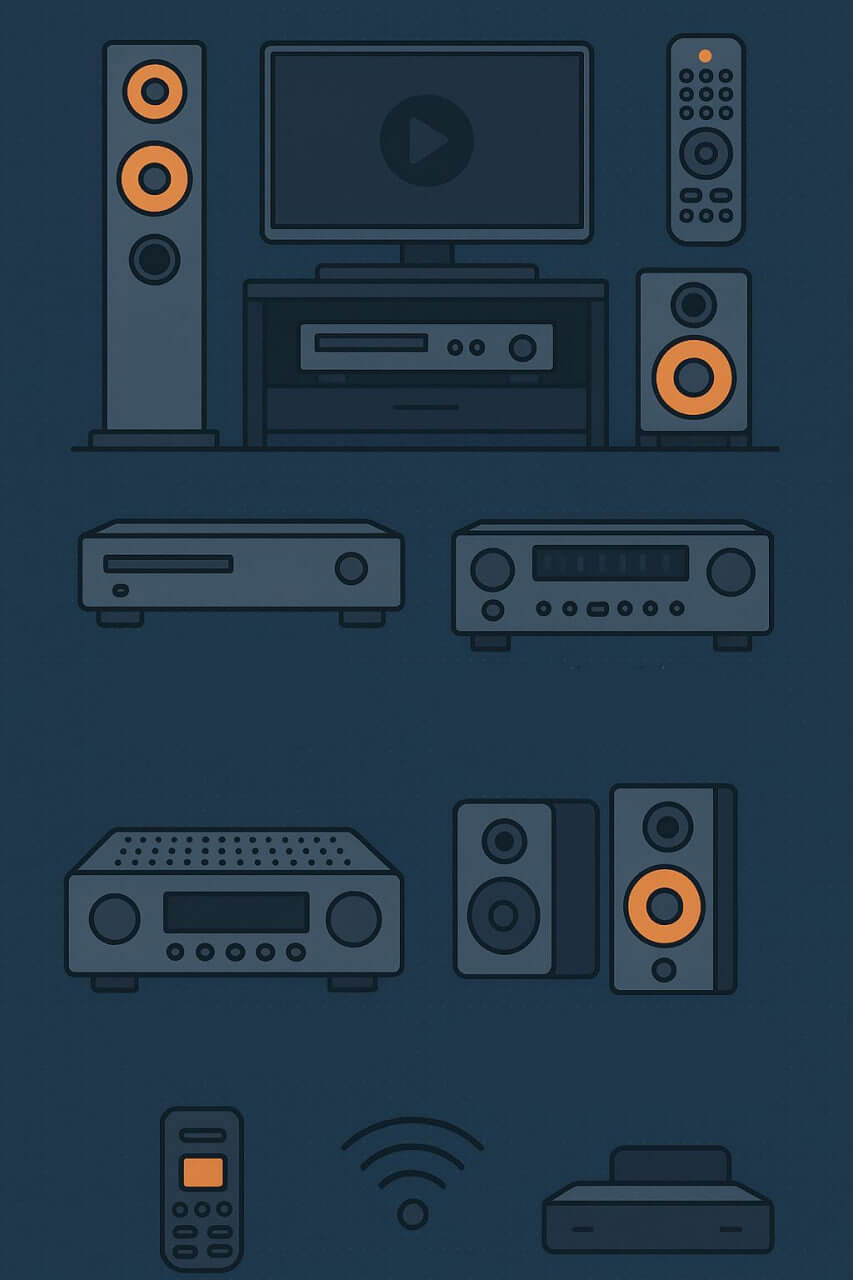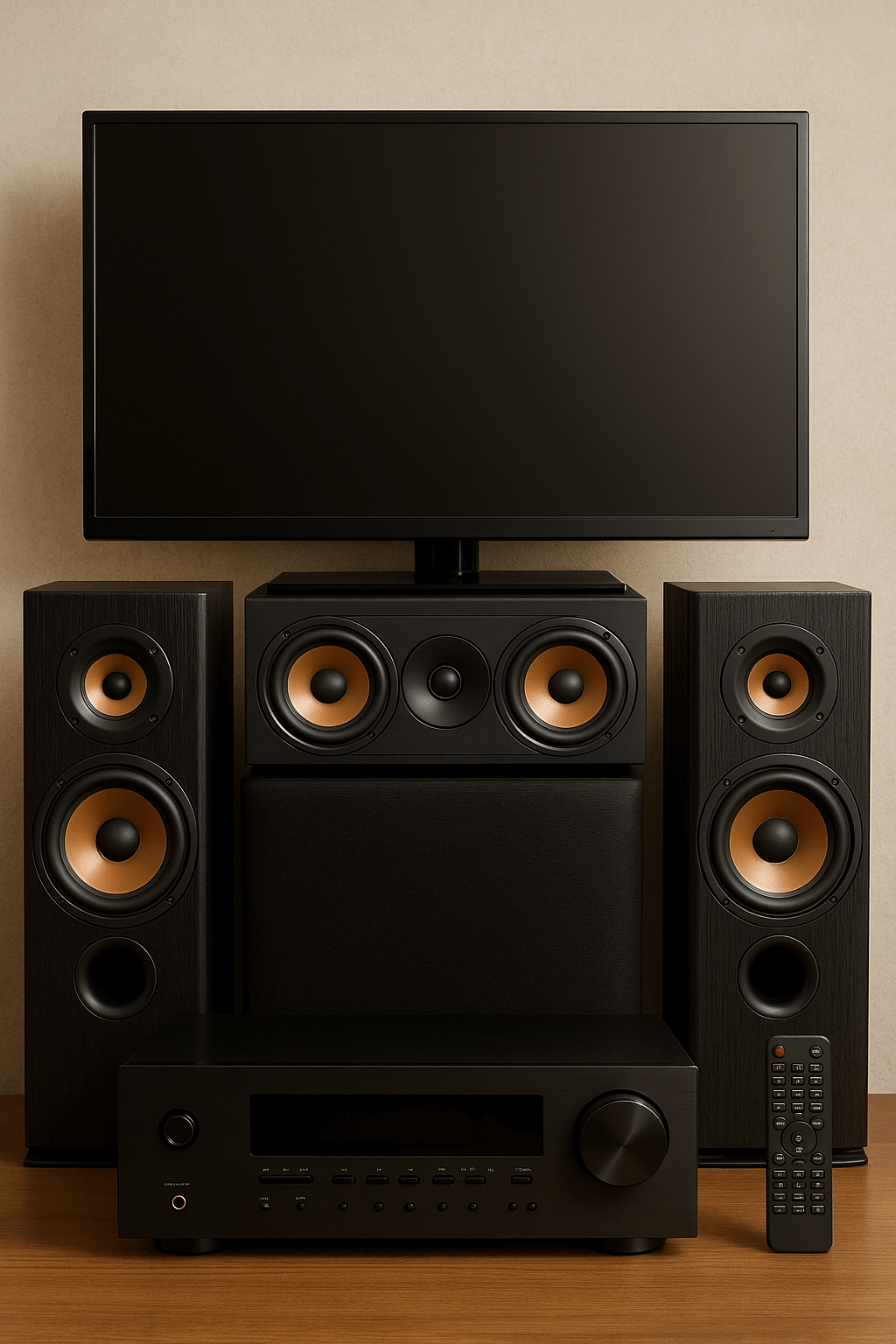Clearance of Home Theater Systems from Iranian Customs (HS Codes + Documents & Permits)

For an estimate of time and cost for clearing Home Theater Systems, contact the experts at Saba Tarkhis.
Immediate Free Consultation1) Specifications and Components of Home Theater Systems
Blu-ray and DVD players play a key role in delivering high-quality video content. These devices must support playback of high-resolution video files and typically use advanced technologies to provide a cinema-like experience.
One important part of a home theater is the audio/video processing system. These systems refine and optimize audio and video signals to improve final sound and picture quality. Processing equipment may include audio amplifiers, digital-to-analog converters, and various controllers.
Amplifiers boost audio signals so that speakers output high-quality sound at appropriate volume levels. Multi-channel amplifiers (such as 5.1 or 7.1) are used to distribute surround sound in home environments.
Multi-channel speakers are another key part of home theater systems that create an immersive, realistic experience by distributing sound in different directions. These speakers are typically placed around the room to provide more lifelike surround sound.
Modern home theater systems often include smart remote controls that allow users to fully manage playback, audio/video settings, and connectivity with other smart devices.
2) Customs Tariff (HS Code) for Home Theater Systems
- Audio equipment is classified under tariff code 8518, which includes amplifiers and loudspeakers.
- Video equipment is placed under tariff code 8521, which covers Blu-ray and DVD players.
- If these devices are imported as an integrated Home Theater System, tariff code 8521.90 for multi-purpose devices applies.
| Item / Component | Short Description | HS Code |
|---|---|---|
| Amplifiers and Audio Boosters | Amplifiers; Multi-channel 5.1/7.1 | 8518 |
| Loudspeakers (Passive/Active) | Loudspeakers; Components | 8518 |
| Blu-ray / DVD Player | Video players; optical disc | 8521 |
| Integrated Home Theater System | Multi-purpose audio-video set | 8521.90 |
Final line classification depends on brand/model, connectivity (Wi-Fi/BT), whether imported as a complete kit or separate parts, and intended use.
3) Legal Requirements and Permits for Importing Home Theater Systems
National and International Standards
Legal Permits from Relevant Authorities
Quality Control Inspections and Tests
4) Exporting and Importing Countries for Home Theater Systems
5) Import and Export Volumes of Home Theater Systems to Iran
6) Global Turnover of Home Theater Systems
7) Top Exporting and Importing Countries
The largest exporters of Home Theater Systems worldwide include the following countries:
China: The largest exporter of electronics and Home Theater Systems thanks to powerful production infrastructure and low manufacturing costs.
South Korea: With renowned brands such as Samsung and LG, this country plays an important role in the global market.
Japan: Reputable brands like Sony and Panasonic are known for producing high-quality Home Theater Systems.
Germany: With high-tech products and well-known audio/video brands, Germany also has a notable role in exporting these devices.
Globally, the following are among the largest importers of Home Theater Systems:
United States: One of the largest consumer markets for home theater equipment due to high demand for quality products.
European countries: European markets owing to technological growth and consumer affluence are prime destinations for Home Theater System imports.
Middle Eastern countries: Iran and other nations in the region, due to rising consumerism and demand for electronics, constitute one of the large import markets for Home Theater Systems.
8) Required Documents for Clearing Home Theater Systems
1. Commercial Invoice (Invoice)
Issued by the seller/exporter, the invoice includes information such as price, payment terms, quantities, and types of imported devices. This document must fully match other papers and is one of the primary clearance documents.
2. Packing List
The packing list describes the contents of each package in detail. It includes item counts, gross and net weights, and dimensions. Customs uses this to reconcile package contents with information provided in other documents.
3. Bill of Lading (B/L)
The bill of lading is submitted to customs as the transport document. It contains details such as the mode of transport (sea, land, or air), origin and destination, and shipment particulars. The carrier issues this document, and customs uses it to manage entry procedures.
4. Certificate of Origin (CO)
Issued by the exporting country’s chamber of commerce, the CO indicates where the goods were manufactured. It is used to determine customs tariffs and to obtain preferential rates under trade agreements.
5. Order Registration License
For importing any goods into Iran, an order registration license from the Ministry of Industry, Mine and Trade (MIMT) is mandatory. It shows that the import is legally permitted and the order registration process is complete.
6. HS Code (Customs Tariff Code)
The HS Code must be precisely stated for Home Theater Systems and related parts in import documents. These codes determine the customs duties and taxes applied to the goods.
7. Standard Certificate
Home Theater Systems must comply with Iran’s national standards. This certificate is issued by ISIRI and ensures the goods meet the country’s safety and quality regulations.
8. Inspection Certificate
For certain goods including sensitive electronic equipment such as Home Theater Systems inspection and quality approval by accredited bodies may be required. This certificate indicates technical and quality compliance.
9. Permits from Specific Agencies
In some cases, importing devices with wireless communications or internet capabilities requires special permits from agencies such as the Communications Regulatory Authority.
10. Customs Declaration
Prepared by the importer and submitted to customs, the declaration contains details such as the type of goods, item counts, shipment value, and origin/destination. It is a key part of the clearance process.
11. Release Certificate
After verifying and approving documents and paying all customs charges and duties, customs issues the release certificate allowing the importer to remove the goods from customs and send them to the final destination.
Need precise HS classification, permits, and document preparation? Our team manages your case end-to-end.
Submit a Proforma Request9) Best Practices for Clearing Home Theater Systems from Iranian Customs
1) Pre-technical inquiry with ISIRI and the Communications Regulatory Authority if wireless modules (Wi-Fi/BT) are present.
2) Prepare consolidated HS when importing as an integrated kit, or separate HS codes for individual components.
3) Match documents (Invoice, Packing List, CO, B/L) with technical specs and serial numbers.
4) Packaging & labeling per safety standards and energy labeling where applicable.
5) Pay duties/taxes according to the tariff line and obtain the release certificate.

Frequently Asked Questions
Do integrated Home Theater systems have a separate HS code?
Integrated multi-purpose devices are typically declared under 8521.90; however, final determination depends on features and technical documentation.
What permit is required for devices with Wi-Fi/Bluetooth?
As applicable, approval from the Communications Regulatory Authority is required; technical documents and EMC/EMI tests may be requested.
Is it possible to declare components separately?
Yes. Speakers/amplifiers (8518) and players (8521) may be declared separately; however, when imported as a complete set, 8521.90 is more common.
Specialized Clearance Services by Saba Brokerage
With years of experience in clearing electronic goods, Saba Brokerage offers specialized, premium services to streamline clearance of Home Theater Systems. These services help importers complete the process with greater speed and accuracy.
Pre-import expert consulting: Our specialists provide professional guidance, accompanying importers through all stages from supplier selection to clearance. This includes detailed information about customs tariffs, required permits, and how to manage import costs ensuring importers are fully informed and can make optimal decisions.
Document management: One major challenge in clearance is preparing and completing required paperwork. Using up-to-date systems and experienced staff, we fully manage all documents including the commercial invoice, packing list, certificate of origin, and other necessary permits reducing errors and preventing potential issues during clearance.
Obtaining legal permits: We handle all permits needed from government bodies, including ISIRI approvals and MIMT authorizations. Managing permits and follow-ups with relevant entities significantly accelerates the clearance process.
Expediting clearance: A hallmark of our services is speeding up customs clearance. Thanks to extensive experience with national customs and familiarity with procedures, every step from inspection to issuance of the release license is completed in the shortest possible time, helping importers save valuable time.
Post-clearance services: In addition to clearance, we offer comprehensive post-clearance services including inland transportation, warehousing, and distribution to the final destination helping importers deliver goods quickly and seamlessly to their customers.
.png)
